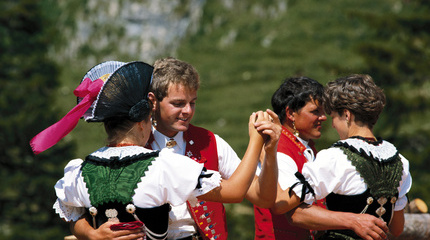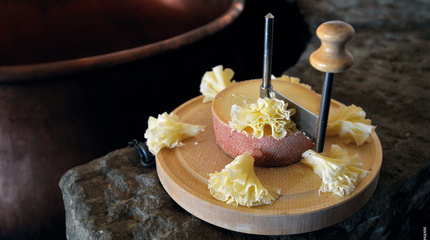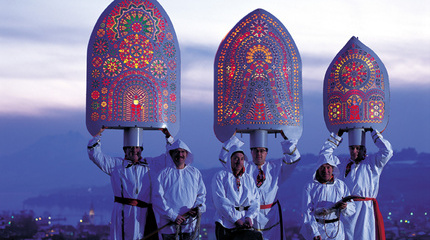Switzerland
“The Swiss have always maintained and nurtured their own local customs, and because of this, Switzerland is a country with an enormous wealth of cultural activity and living tradition.”
Music
“No matter whether there is dancing taking place or not, Swiss folk music is mainly dance music.”
The most commonly heard musical instruments include the "Schwyzerörgeli" (accordion), the violin, bass violin, clarinet and, in certain regions, the dulcimer or Trümpi (Jew's harp). Alpine folk music developed with the unwritten transfer of skills and compositions over generations, decades and even centuries. The oldest known Kuhreihen (rounds) are from Appenzell and were recorded in 1545. The Alphorn, so typically Swiss, was originally a musical and signaling instrument used by the herdsmen and the many yodeling choirs that have been formed since the 19th century. In general, Switzerland has an extensive amateur music scene, and in virtually every village there is at least a choir or a brass band.
On the Alp
“Alpine farming has a long history. It is believed that the pastures above the tree line were being farmed as far back as 4,000 BC.”
Customs and sports
“For a long time, Swiss sports customs were eclipsed by international types of sport - but recently, they have come back into their own.”
While regional and local sporting traditions have often been neglected, there are some sports that have enjoyed increasing popularity. Major events such as the Swiss Wrestling and Alpine Festival ESAF are increasing in popularity; in 2010, the festival reached a new record with 250,000 visitors and became the largest Schwingen festival ever held. It is worth noting that no additional police were needed for the maintenance of order, and the authority of the public address announcer was sufficient. At these multi-day festive occasions, athletic wrestlers, sturdy boulder throwers and strong Hornussen players gave of their best - all to the accompaniment of yodel choirs and accordion orchestras.
Typical food and wine
“The food in Switzerland is a potpourri of influences from various countries. It combines the cuisines of its neighbours and creates from them a local cuisine with local ingredients.”
iThere are a few dishes and specialities, such as fondue, Älplermagronen and chocolate, that are typical of Switzerland, but there is no real Swiss cuisine to speak of. There is a cuisine with Bernese Platter and Bernese Rösti. A cuisine with Vaud sausage and leeks. A cuisine with St Gallen Rabelais and whitefish from Lake Constance. The Valais is famous for its raclette, Graubünden for its campus, Zurich for its Geschnetzeltes, Lucerne for its Chügelipastete and Ticino for its Mortadella und Luganighe. You will find sausage everywhere – Switzerland is home to almost 350 different varieties. And that is - in terms of land area - clearly a world record. And incidentally, while not quite the world leader, the Swiss wines are well on the way there. Besides the well-known classics, Switzerland provides for unique tasting pleasure with its new types of wine and development of indigenous varieties.
St Nicholas' Day traditions
The customs surrounding St Nicholas are concentrated on the eve of St Nicholas' Day (6 December), although they start at the end of November in the Glarus Region and end at the beginning of January in the Appenzeller Hinterland. The celebrations on St Nicholas' Day itself ("Samichlaus" in German-speaking Switzerland) are predominantly for children. In Catholic areas children learn special Samichlaus verses which they then recite to Samichlaus (bishop figure) and his helpers (Schmutzli, Butzi, père fouettard) in return for sweets. There are female equivalents of Samichlaus in Italian-speaking Ticino (Befana) and in French-speaking Switzerland (Chauche-vieille).
Christmas traditions
In 325 the Council of Nicaea pinpointed 25 December as the date of the birth of Christ. By choosing a date near the winter solstice they hoped to eclipse the pagan midwinter rituals and festivities. It started out as a purely religious festival but gradually evolved into a family celebrations centred around the Christmas meal. The tradition of giving gifts and the Christmas tree only started spreading in the 20th century from the towns and cities to the villages. The general tradition in Ticino is to set up the nativity scene in the home and to put up a fir tree with decorations in the village square. Songs and instrumentals have become fundamental elements of a traditional Christmas. It is popular to make music in the home during the Advent season but there are also church concerts, trumpet fanfares from towers, carol singing, public singing and the serenades of the Salvation Army. They are often held to collect money for good causes and people are increasingly donating to such good causes instead of exchanging gifts.
Epiphany carol singing
Epiphany carol singing, a custom which falls between the fourth Sunday in Advent and Twelfth Night (6 January), has its roots in medieval plays. The Epiphany carol singers, who are often children dressed up as the three wise men or a choir bearing the star, sing on village squares or go from house to house, symbolising the fellowship of all parishioners. In Lucerne and Wettingen, canton of Aargau, the Epiphany carol singers perform a play on the Sunday before Christmas.
New Year customs
It is not only corks which people hear popping on New Year's Eve. The end of the year is marked by loud processions in many places with masked figures, the sound of fireworks and drums, the ringing of bells and the cracking of whips. There is a belief that this New Year's Eve tradition will ward off demons and evil spirits. Again, the way in which this belief is enacted differs greatly from region to region. The noise at the School Silvester, a traditional New Year's Eve school in Zurich, is made by a crowd of children and young people while the Trickle procession in Meiringen involves young men with cowbells. In Wil children with brightly coloured lanterns process through the dark streets, and at the Silvester Dreschen New Year's Eve threshing in Hallwil the old year is thrashed out with rhythmic beating of the threshing board. In Urnäsch the men at the Sylvester Klausen New Year's Eve parade go from house to house – and, in the evening, from restaurant to restaurant accompanied by the ringing of bells.
Shrove Tuesday customs
by Daniella Monge
No hay comentarios:
Publicar un comentario